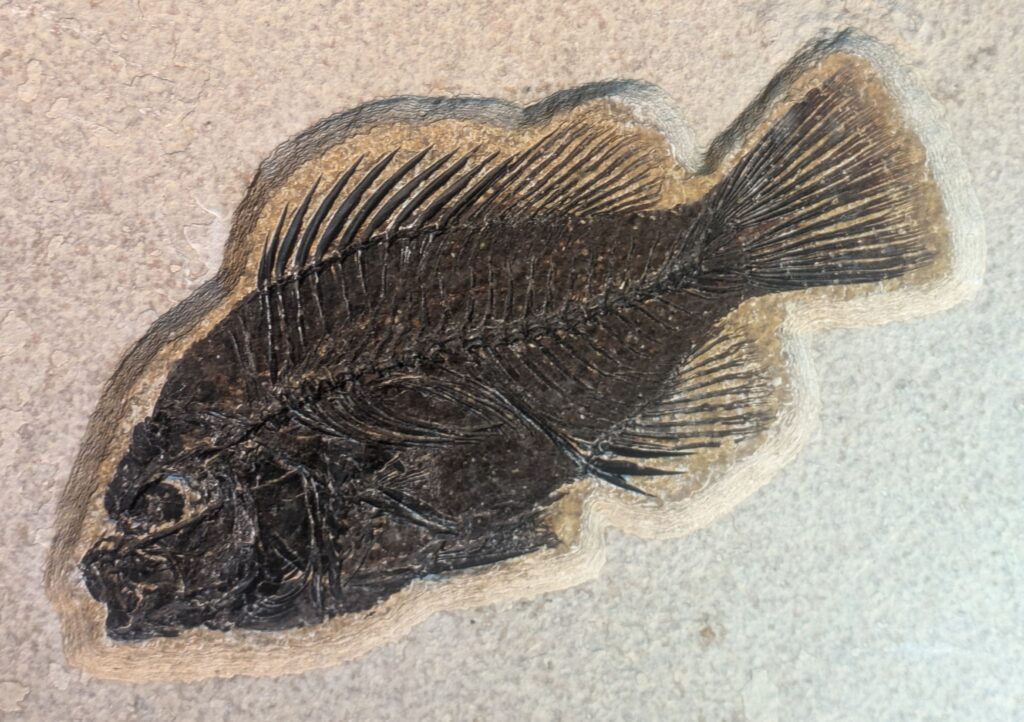The Green River Formation, spanning parts of Colorado, Utah, and Wyoming, is one of the most remarkable fossil sites in the world. Dating back to the Eocene Epoch (approximately 56 to 33.9 million years ago), this formation provides a detailed snapshot of life in and around ancient freshwater lakes. Renowned for its exceptional fossil preservation, the Green River Formation has yielded a diverse array of plants, animals, and microorganisms, offering insights into an ecosystem that thrived nearly 50 million years ago.
Geological Context
The Green River Formation was deposited during the Eocene in a region of the western United States that was part of a subtropical environment. It consists of sedimentary rocks, primarily shale, limestone, siltstone, and sandstone, which were laid down in three large lake systems:
- Lake Gosiute: Located in present-day Wyoming.
- Lake Uinta: Found in northeastern Utah and northwestern Colorado.
- Fossil Lake: A smaller lake in southwestern Wyoming, known for its exceptionally preserved fossils.
These lakes existed in a period of global warmth, known as the Eocene Climatic Optimum, and were surrounded by forests, wetlands, and volcanic landscapes.
Fossil Preservation: Lagerstätte of the Eocene
The Green River Formation is a Lagerstätte, a site of extraordinary fossil preservation. This preservation is attributed to several factors:
- Anoxic Bottom Waters: Low oxygen levels at the lake bottoms slowed decay and prevented scavenging.
- Fine Sediments: Layers of fine-grained sediment buried organisms quickly, preserving delicate features like feathers, scales, and even stomach contents.
- Seasonal Deposition: Seasonal variations in sediment deposition created thin laminations, preserving fossils in exquisite detail.
Fossil Diversity
The Green River Formation is famous for its incredible diversity of fossils, providing a snapshot of life in and around Eocene lakes.
Fish
Fish fossils are among the most abundant and iconic finds:
- Knightia: A small schooling fish and Wyoming’s state fossil.
- Diplomystus: A larger predatory fish, often found fossilized with smaller fish in its stomach.
- Priscacara: A perch-like fish with well-preserved spines and scales. These fish fossils are so detailed that they reveal fine structures like fin rays and even scale patterns.
Reptiles and Amphibians
- Fossils of crocodiles, turtles, and lizards are common, showcasing the warm, wet climate of the Eocene.
- Well-preserved frogs and salamanders provide insight into amphibian diversity in the region.
Birds
The formation has yielded spectacular bird fossils, including:
- Early shorebirds and waterfowl.
- Fossilized feathers, showing fine details and even pigment structures, which offer clues about coloration.
Mammals
Though less common than fish, the Green River Formation has produced fossils of early mammals, such as small rodents and bats. These fossils provide evidence of life in the forests and grasslands around the lakes.
Plants
The flora of the Green River Formation includes:
- Fossilized leaves, seeds, and fruits from trees like sycamores, palms, and figs.
- Algae and diatoms preserved in the lake sediments. These plant fossils reveal the subtropical climate and rich biodiversity of the region.
Insects and Arthropods
Delicate insects such as dragonflies, beetles, and wasps are preserved with incredible detail, often showing fine wing venation. These fossils highlight the diversity of arthropods in the ancient ecosystem.
Geological and Economic Significance
Beyond its paleontological importance, the Green River Formation holds significant geological and economic value:
- Oil Shale: The formation contains vast deposits of oil shale, making it one of the largest known sources of hydrocarbons in the world. These deposits represent organic material from algae and other organisms that accumulated in the ancient lakes.
- Minerals: Evaporite minerals like trona and nahcolite are mined from the formation, used in industries such as glassmaking and baking soda production.
Research and Insights
The Green River Formation provides key insights into the Eocene Epoch, including:
- Climate and Ecology: Fossils reveal details about Eocene climates, which were warmer and wetter than today, and help reconstruct ancient ecosystems.
- Evolution: The diverse fossils showcase evolutionary trends, particularly in fish, birds, and mammals, during the early stages of modern biodiversity.
- Paleoenvironment: The laminated lake sediments offer a year-by-year record of environmental changes, akin to tree rings.
Famous Fossil Sites
- Fossil Butte National Monument (Wyoming):
- Known for its rich fish fossils, particularly from Fossil Lake.
- American Fossil Quarry (Wyoming):
- Offers opportunities for public fossil collecting, contributing to research and education.
Legacy and Importance
The Green River Formation remains a cornerstone of paleontology, celebrated for its exceptional preservation and scientific value. Its fossils continue to captivate researchers and collectors, providing a vivid glimpse into life during the Eocene. Beyond its beauty and intrigue, the Green River Formation reminds us of the dynamic interplay between life, climate, and geology over millions of years.
By studying its fossils and rocks, scientists gain not only a deeper understanding of ancient ecosystems but also a clearer perspective on how life responds to environmental changes—an invaluable lesson in our own era of rapid ecological transformation.


